Ban Non Wat
|
บ้าน โนน วัด Ban Non Wat |
||
|---|---|---|
|
|
||
| Coordinates | 15 ° 16 ′ N , 102 ° 16 ′ E | |
| Basic data | ||
| Country | Thailand | |
| Nakhon Ratchasima | ||
| ISO 3166-2 | TH-30 | |
Ban Non Wat ( Thai บ้าน โนน วัด ) is a village in the municipality of Mu 11 ( tambon ) Phon Songkhram district ( Amphoe ) Non Sung , province of Nakhon Ratchasima , near the small town of Phimai .
Ban Non Wat is an archaeological site surrounded by a ditch in the catchment area of the Mae Nam Mun (Mun River) on the Khorat Plateau with an area of around 892 m². Since 2002, under the direction of Charles Higham , today Dr. Nigel Chang from the Earthwatch Institute funded excavation . The found objects and the circumstances go back to the Neolithic , the Bronze Age and the Iron Age . A prehistoric center for copper mining was found . In particular, the 637 tombs that contain a lot of artifacts are examined . It is believed that the area has been continuously inhabited for around 3000 years (Higham, 2009).
According to more recent findings, the production of bronze began as a brief cultural outbreak around 1000 BC. Then the population in the area increased massively. Salt was extracted on a large scale in the early Iron Age . At the same time social tensions arose, which can be seen in the emerging production of iron weapons and the construction of ramparts and ditches around the settlements. These factors eventually led to the rapid formation of early Southeast Asian states in the 4th and 5th centuries .
The surrounding rice fields have most likely been artificially irrigated for thousands of years . Many of the finds point to the Khmer culture, which is not surprising, as the place is close to the old overland connection of the Khmer Empire to the west to the Mae Nam Chao Phraya and through the valley of the Mae Nam Mun a good connection to the Mekong offers.
Nearby is the archaeological site of Ban Prasat .
Web links
- Charles Higham and Thomas Higham : A new chronology framework for prehistoric Southwest Asia, based on a Bayesian model from Ban Non Wat. In: Antiquity. Vol. 83 (2009), pp. 125-144.
